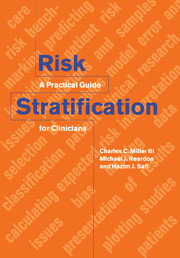Introduction
Published online by Cambridge University Press: 22 March 2010
Summary
The mathematical prediction and stratification of medical risk has received increased attention in recent years, as interest in comparing and rating health care provider organizations has grown. Some of this interest has been driven by competition between organizations that wish to show their own results as compared to those of their competitors down the street or across the country. Some of the interest has come through governmental oversight and the declaration of performance standards based on risk expectations. The state of New York, for example, influences the practice patterns of physicians who perform coronary bypass operations by publishing comprehensive statewide risk stratification program results (1). Perhaps the greatest interest among individual practices and institutions has been developed in response to questions posed by managed care companies, as risk-adjusted results have become a more important part of contracting. There are many reasons for collecting data on local performance and considering the implementation of some sort of risk stratification program in nearly every clinical practice organization.
A feature common to all risk stratification, regardless of its ultimate purpose, is that it compares outcomes from a particular institution or clinical practice with those of a recognized standard. In making such comparisons, risk stratification considers risk factor distributions that may not be identical between the populations being compared, and uses the risk factors to explain some of the variation in the outcomes of one population based on expectations derived from another. The process requires that a risk model of some sort, which serves as the standard for comparison, be applied to local risk factor data.
- Type
- Chapter
- Information
- Risk StratificationA Practical Guide for Clinicians, pp. 1 - 6Publisher: Cambridge University PressPrint publication year: 2001



